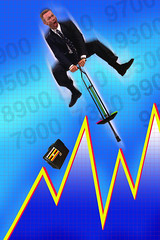The Brave New World Of Trading
Over the last few years the world has changed dramatically for traders. New places to trade, much cheaper prices, combined with a wide range of uniquely focused (some might say, exotic) product offerings have consistently expanded profit opportunities for traders of all experience levels.
And despite the upheaval caused to some in the industry over the past dozen or so years (in particular, the old-school brokers), these changes seem to have been extremely beneficial to the markets at large. No question, digital technology has helped make trading much simpler and more accessible for both individuals and larger entities alike.
As evidence, look to the array of Internet brokers that offer round-the-clock, browser-based order fills. An online smorgasbord of underlying instruments that, up until just a few years ago was only accessible to the most sophisticated managers, is now available to most traders. And real-time market-data providers now offer timely and consistent updates from around the globe. Add to this the fact that hundreds (possibly thousands) of developers and software publishers have sprung up in recent years to create programs that help traders crunch all of this data together in hopes of making huge profits.
But as with all new-found and evolving opportunities, there are new-found risks. And in the minds of many observers, traders need look no further than the Flash Crash of May 2010 to underscore the immense downside these new technologies can expose market participants to. No question, a lot really has changed over the last generation for traders. Unfortunately, many are worried that some players have adapted to the changes a little too well.
In particular, the rise of the computerized, algorithm-packing, high-frequency trader has spawned fears of a highly automated marketplace that crowds out all but the most technically savvy code jockeys. And though these systems may not have caused the meltdown, it certainly raises questions as to what precisely rocked the system in such a fashion. Indeed, some regulators have begun to fret the exchange fragmentation that has come out of deregulation—and that the HFT’s thrive on for price discovery—could actually be replacing some of the roles traditionally performed by regulated market makers.
Ironically, the same folks many look to to solve this dilemma are the same people some blame for getting us into it in the first place. Yes, of course we’re talking about the Federal government. And the story is pretty long and convoluted, but the short version has the SEC, acting on directives from Congress, deciding to foster competition and embrace electronic trading.
And as a result of changes in regulatory structure, a whole new class of customers sprung up (high-frequency traders being the most prominent), along with new exchanges—each with slightly different rules designed to keep traders trading on their exchanges—in addition to whole new ways of buying and selling stocks outside of exchanges (such as dark pools, crossing systems, etc.). Some believe these changes were necessary in order to keep market volumes (and liquidity) high. Others think that they have simply opened up a new can of dangerous and opaque worms for the investing public.
Unquestionably, HFT’s have increased liquidity across all markets. But has this led to better pricing, or worse? And have high-frequency traders “taken advantage” of retail investors, as some have alleged? Or, has the ascendancy of automated trading, practiced so well by many in the high-frequency crowd, actually opened up an entirely new avenues of opportunity for the “average” investor? The Securities and Exchange Commission releases its final report on The Flash this month. Some are content that safeguards are already in place to prevent another meltdown, but many others worry that a much bigger and badder “correction” (or series of them) is on the horizon—and they’re blaming a fragmented marketplace run by machines, not humans, as the root of their anxiety.
Check out CNBC’s website for a great series of articles detailing how the entire trading industry has changed, the pros and cons of all the new market systems available as well as a behind-the-scenes look at the various new trading venues.
Related articles by Zemanta
- HUGE: First High Frequency Trading Firm Is Fined For Quote Stuffing And Manipulation (businessinsider.com)
- Regulator Takes Aim at High Frequency Traders (blogs.forbes.com)
- First high-frequency trading firm fined for manipulation (financialpost.com)
- High Frequency Trader Fined: ‘Quote-Stuffing’ Crackdown Afoot? (blogs.wsj.com)
- How The War Between High Frequency Traders And Day Traders Will Soon Change (businessinsider.com)
- Ex-Physicist Leads Flash Crash Inquiry (econotwist.wordpress.com)
- SEC Investigator: Flash Crash Probably Wasn’t Market Manipulation (observer.com)

Mashups and APIs
- Home
- About Us
- Write For Us / Submit Content
- Advertising And Affiliates
- Feeds And Syndication
- Contact Us
- Login
- Privacy
All Rights Reserved. Copyright , Central Coast Communications, Inc.
